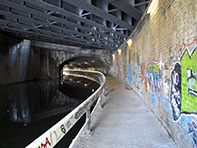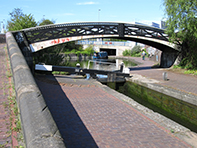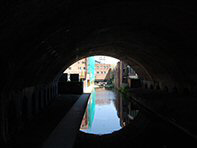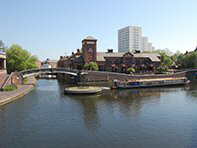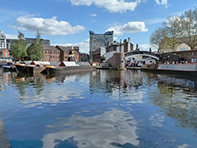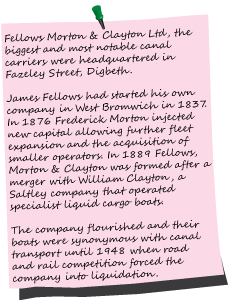
Bordesley to Gas Street Basin
The Digbeth Branch is interesting in an industrial sense, so don't be put off by the unremittingly grim scene as you go under Great Barr Street and what looks like a disused railway bridge but in fact the railway didn’t came this way and it was never used. Continue and you cross a bricked up arch where boats full of garbage once deposited their loads at one of the city’s main refuse collection sites. The Bond is on the left, formerly used to store ice it is now an office and conference complex and then there is the massive rounded Fellows, Moreton and Clayton warehouse. Further on, next to the Warwick Bar Stop Lock, is the toll office and former Geest banana warehouse. This is the start/end of the branch canal, much of Digbeth is a conservation area and rewarding to wander around with some fine buildings and interesting regeneration.
However, to finish the Grand Union Walk into the City Centre, carry on under the two bridges. Straight in front across the junction is the Gun Barrel Proof House, the Typhoo Tea warehouse and Pickfords' wharfs would be found if you turned to the left. Turning right you enter the Curzon Street Tunnel. Luckily well lit, it is 160 yards long and fairly eerie with the sound of roosting pigeons and the rumble of trains overhead. Curzon Street Station, a splendid building now isolated on the Eastside building site, was the terminus for the London and Birmingham railway in 1838 and will spring back into life again if HS2 is built. Immediately after the tunnel are the six Ashted Locks. Above Lock 2 is a 103 yard low, narrow tunnel. When you emerge it’s like you’ve been transported to Milton Keynes, for this is the glossy Birmingham Science Park. With 48hr moorings, this is a bright and airy stretch past shiney steel and glass buildings to Aston Junction and the Birmingham and Fazeley Canal.
Once over the 1829 Horseley bridge you go under Aston Road and over the first of several bricked up wharfs that line the canal, opened in 1789 by the Birmingham Canal Company, later the Birmingham Canal Navigations Company. With links to various other canals and rivers, and with over a hundred wharfs, the Birmingham and Fazeley was worked 24 hours a day, seven days a week, becoming exceedingly congested and necessitating the building of the Birmingham and Warwick Junction Canal.
With the BT Tower acting as a guide under Newtown Row you pass a mixture of old industrial buildings on the fringes of the Gun Quarter and new buildings until after Barker Bridge you reach Old Snow Hill and Farmer’s Bridge Bottom Lock. The ‘Old Thirteen’ climbs 81ft to the City Centre, for a large part ducking and diving through a Dickensian underworld. Entering a gigantic cavern carrying the lines leading into Snow Hill Station - leafy rural Warwickshire seems a long way distant, you are now in the heart of darkness.
Continuing to Lock 12 just past Livery Street and the area is a mixture of offices and flats up to Ludgate Hill and Lock 11. The canal disappears under Brindley House, an office turned apartment block built on stilts, and onto Lock 10. The next lock is directly under Newhall Street and it was here that the canal ran through famous electroplating firm of Elkingtons, the world's largest metalworking factory. Now skirting the Jewellery Quarter you emerge into the open for Lock 8 which is overlooked by swish new apartments. The vicinity still produces the majority of jewellery in Britain and the Assay Office, set up in 1773, is the busiest in Europe, stamping its anchor on 5.8 million items annually.
Lock 7 appears just before a new walkway, 6 and 5 are reached before Saturday Bridge. There aren’t too many people about, mountain bikers, joggers, the odd snapper and the drunks you encounter are liable to be over friendly rather than dangerous although their choice of urinal can be random. The rest of the flight now comes into view with the National Indoor Arena in the distance. The Top Lock is adjacent to Cambrian Wharf and the former Newhall Branch. Another Horseley Bridge is there to go under passing the Toll House and then under Tindall Bridge to Old Turn with the unique island dating from World War II and its sign post installed by the BCN Society in 1983. (The B'ham - Wolverhampton railway tunnels underneath)
Go left over the bridge by the Malt Shovel pub and the end is in sight along a towpath full of shoppers and tourists. Pass Sherborne Wharf and the International Convention Centre and you reach Gas Street Basin where the walk ends. The iron bridge connecting Worcester Bar to the towpath is not original, but said to be the first of its type to be forged for 100 years when the area was regenerated. You can now celebrate in one of the many bars on Broad Street.
However, to finish the Grand Union Walk into the City Centre, carry on under the two bridges. Straight in front across the junction is the Gun Barrel Proof House, the Typhoo Tea warehouse and Pickfords' wharfs would be found if you turned to the left. Turning right you enter the Curzon Street Tunnel. Luckily well lit, it is 160 yards long and fairly eerie with the sound of roosting pigeons and the rumble of trains overhead. Curzon Street Station, a splendid building now isolated on the Eastside building site, was the terminus for the London and Birmingham railway in 1838 and will spring back into life again if HS2 is built. Immediately after the tunnel are the six Ashted Locks. Above Lock 2 is a 103 yard low, narrow tunnel. When you emerge it’s like you’ve been transported to Milton Keynes, for this is the glossy Birmingham Science Park. With 48hr moorings, this is a bright and airy stretch past shiney steel and glass buildings to Aston Junction and the Birmingham and Fazeley Canal.
Once over the 1829 Horseley bridge you go under Aston Road and over the first of several bricked up wharfs that line the canal, opened in 1789 by the Birmingham Canal Company, later the Birmingham Canal Navigations Company. With links to various other canals and rivers, and with over a hundred wharfs, the Birmingham and Fazeley was worked 24 hours a day, seven days a week, becoming exceedingly congested and necessitating the building of the Birmingham and Warwick Junction Canal.
With the BT Tower acting as a guide under Newtown Row you pass a mixture of old industrial buildings on the fringes of the Gun Quarter and new buildings until after Barker Bridge you reach Old Snow Hill and Farmer’s Bridge Bottom Lock. The ‘Old Thirteen’ climbs 81ft to the City Centre, for a large part ducking and diving through a Dickensian underworld. Entering a gigantic cavern carrying the lines leading into Snow Hill Station - leafy rural Warwickshire seems a long way distant, you are now in the heart of darkness.
Continuing to Lock 12 just past Livery Street and the area is a mixture of offices and flats up to Ludgate Hill and Lock 11. The canal disappears under Brindley House, an office turned apartment block built on stilts, and onto Lock 10. The next lock is directly under Newhall Street and it was here that the canal ran through famous electroplating firm of Elkingtons, the world's largest metalworking factory. Now skirting the Jewellery Quarter you emerge into the open for Lock 8 which is overlooked by swish new apartments. The vicinity still produces the majority of jewellery in Britain and the Assay Office, set up in 1773, is the busiest in Europe, stamping its anchor on 5.8 million items annually.
Lock 7 appears just before a new walkway, 6 and 5 are reached before Saturday Bridge. There aren’t too many people about, mountain bikers, joggers, the odd snapper and the drunks you encounter are liable to be over friendly rather than dangerous although their choice of urinal can be random. The rest of the flight now comes into view with the National Indoor Arena in the distance. The Top Lock is adjacent to Cambrian Wharf and the former Newhall Branch. Another Horseley Bridge is there to go under passing the Toll House and then under Tindall Bridge to Old Turn with the unique island dating from World War II and its sign post installed by the BCN Society in 1983. (The B'ham - Wolverhampton railway tunnels underneath)
Go left over the bridge by the Malt Shovel pub and the end is in sight along a towpath full of shoppers and tourists. Pass Sherborne Wharf and the International Convention Centre and you reach Gas Street Basin where the walk ends. The iron bridge connecting Worcester Bar to the towpath is not original, but said to be the first of its type to be forged for 100 years when the area was regenerated. You can now celebrate in one of the many bars on Broad Street.
View Bordesley to Gas Street in a larger map
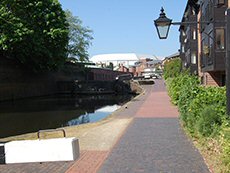
Hover over bold italic text and photographs for extra information
